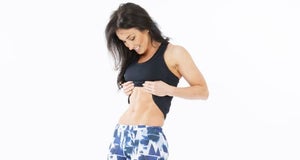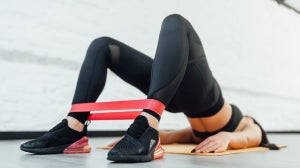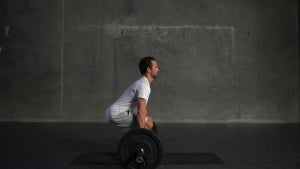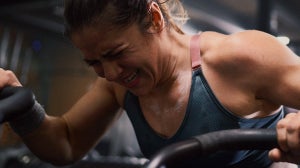
What are resistance bands?
Resistance bands are stretchy, lightweight bands that come in a variety of thicknesses and lengths, and are used as a tool for training and rehabilitation to work out different areas of the body.There are a number of different styles of band depending on what you plan to use them for, including small, rehabilitation bands, thicker figure-eight bands for upper-body workouts, and looped bands for lower-body workouts.
Do resistance band workouts really work?
Yes — resistance bands are great for building strength and muscle. A 2019 study found that resistance band training can produce similar strength gains to conventional resistance training.1
As with all equipment, it’s important they are used effectively and correctly.
What is resistance training?
Resistance training is the act of lifting (pulling or pushing) the body against some form of resistance. It can be done using resistance bands, conventional weights or even bodyweight movements, and is usually done to build muscle size, strength or endurance.
Are resistance bands good for weight loss?
To lose weight, the body needs to burn more calories than it takes in. Bodies with greater muscle mass will typically burn more calories than those with less. Resistance bands can be a great way to build muscle, which would in turn lead to more calories burnt. Performing 3-4 resistance band workouts a week can be a great way to build muscle and burn fat. By hitting the right reps and sets, you can lose weight effectively.
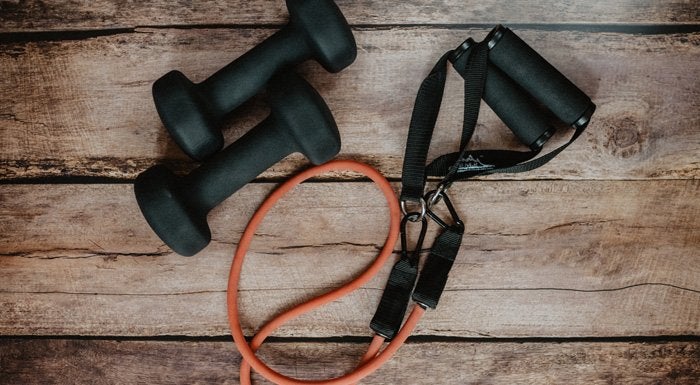
Are resistance bands good for building muscle?
Muscles are built by overloading through training to induce microtears, which causes them to grow in size. Resistance training is the most effective way of building muscle, and resistance bands can play a key role in it.Working in the same way as traditional weights like dumbbells, resistance bands cause the muscles to have to work hard against resistance, leading to increased strength, size, or endurance over a period of time.
Can resistance bands help tone your stomach?
Spot reduction of fat is impossible — you can’t target fat loss. But resistance bands can be a great way to increase muscle mass and burn calories, which could lead to more-visible abs.
How long does it take to see results from working out with a resistance band?
As with any training programme, you will need to progressively overload to see results. This can be done by increasing band thickness or size, or manipulating reps and sets. When this is done regularly, most people begin to see noticeable differences within 6-8 weeks.
How many times a week should you do resistance band training?
When starting resistance band training, aim for around three 30-60-minute sessions a week. Make these 3 full-body workouts or create an equal upper and lower split with around 4 sessions per week.
Which resistance band should you use as a beginner?
It can be challenging to decide what bands to use when you’re a beginner. The first thing to consider is the area of the body you’re training. For legs, bands will need to be thicker or higher resistance than bands for the upper body. Think about whether a loop band or a tube-based band is better for the movement. Once you know the style, picking the level of resistance is key. You want to complete the movement holding good form, but you also want to feel resistance. As with standard weight training, complete the reps with good form but start to feel a burn in the last 2 reps.Find the right resistance band for you:
27 Resistance Band Exercises for Beginners
Ready to try out some resistance band exercises? We’ve pulled together some exercises for you to try:
1. Banded Front Squat
Squats are a must in any programme and the go-to exercise for serious leg gains.Benefits:builds stronger lower-body muscles and also strengthens the back and core
Muscles Worked: glutes, hamstrings, quads, hip adductors
How to do:
- Using a long resistance band, loop one end around the bottom of both feet, shoulder-width apart on the floor.
- Hold the band with both hands in front of your shoulders with an overhand grip and drive your elbows forward, raising them to around shoulder height.
- Keeping your chest lifted and eyes straight ahead, push the hips back and down by bending at the knees.
- Continue until your upper legs are parallel to the floor. Hold for a second, then slowly return to the starting position.
2. Lateral Walk
Also known as monster walks or side steps, these are great for working on your glutes.Benefits:builds stronger glutes and hip abductors, which help with jumping, running, and twisting movements
Muscles Worked: hip abductors, glutes
How to do:
- Using a small resistance band, loop it around both ankles and stand with your feet shoulder-width apart, making sure the band is taut.
- Soften the knees by bending slightly and sit into a half squat.
- Keeping your chest lifted and eyes straight ahead, start by stepping one foot out to the side until the band is at full stretch. Hold for a second before following with the other foot.
- Keep your hips level and your core engaged.
3. Leg Abduction
Great for rehabilitation or building strength in the hip abductors.Benefits: builds stronger hips abductors and also improves mobility
Muscles Worked: hip abductors, glutes
How to do:
- Loop a small resistance band above your knees and stand sideways with your right hand against a wall.
- Keep your core engaged and head lifted, and start the motion by driving the left leg out sideways as far as you can.
- Pause and hold at the top of the movement for 1-2 seconds, then switch to the other side.
4. Banded Lateral Step-Out Squat
A great variation to regular squats.Benefits: builds stronger lower body muscles but also strengthens the back and core
Muscles Worked: glutes, hamstrings, quads, hip adductors
How to do:
- Place a small resistance band below your knees and stand with your feet shoulder width apart, making sure the band is taut.
- Soften the knees and take a big step out with the right leg. Once your foot is planted, squat down.
- Keeping your chest lifted and eyes straight ahead, start by pushing the hips back and down by bending at the knees.
- Continue until your upper legs are parallel to the floor. Hold for a second, then slowly return to the starting position.
- Step the left leg in and repeat.
5. Side Plank High Pull
A strong core is vital for optimal movements, both in training and day-to-day life.Benefits: builds stronger abs
Muscles Worked: delts, rhomboids, traps, abs, obliques, core
How to do:
- Place a small resistance band loop around both ankles and stand with your feet shoulder-width apart, making sure the band is taut.
- Soften the knees by bending slightly and sitting into a half squat.
- Keeping your chest lifted and eyes straight ahead, start by stepping one foot out to the side until the band is at full stretch. Hold for a second before following with the other foot.
- Keep your hips level and your core engaged.
- Get down onto the floor and into the plank position, looping the band around the hand and inside of the right thumb.
- From the plank position, hold the band in your left hand and then rotate your body into a side plank while pulling the band up.
- Keep your core engaged and make sure your hips are flat. Repeat on the other side.
6. Lateral Raise
Building a strong upper body is a must for anyone serious about training.Benefits: builds stronger delts, which make the shoulders look broader
Muscles Worked: delts
How to do:
- Using a long band, step your feet into it with both the left and right close together. Hold the band in both hands with your arms extended at your sides.
- Soften the knees, engage your core, and avoid arching your back.
- Start the movement by lifting your hands up towards your shoulders, keeping your arms locked out straight.
- Once at shoulder height, hold for a second, and then slowly lower down.
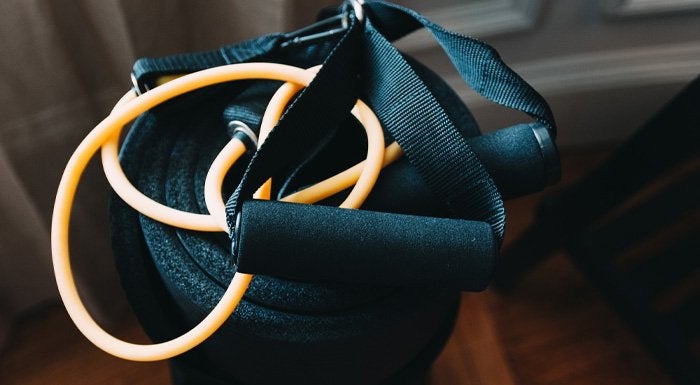
7. Deadlift
The king of compound movements, deadlifts should be a staple in all programmes.Benefits: ideal for building muscular strength and power
Muscles Worked: calves, hamstrings, glutes, erector spinae, lats
How to do:
- Place a long resistance band on the floor and step with both feet on top of the middle.
- Hold each end of the band with your hands and stand with your feet shoulder-width apart.
- Bend your knees and send your hips a few inches backward, keeping your chest up.
- Hinge forward, sending your hips backwards between 30 and 45-degrees.
- Power your hips and glutes forward to stand up straight.
- Keep your knees soft, squeeze your glutes and keep your posterior chain tight.
8. Banded Glute Bridge with Hip Abduction
Build strong and powerful glutes as well as overall lower-body strength.Benefits: builds stronger glutes and hips abductors, which help with jumping, running, and twisting movements
Muscles Worked: glutes, hamstrings, hip abductors
How to do:
- Lie on your back and place a small resistance band between your knees.
- Put your feet flat on the floor as close to your glutes as possible, around shoulder-width apart.
- Start the movement by pushing your hips towards the ceiling and driving through the feet.
- While moving, keep pressing your knees outward against the band. Hold at the top and then slowly lower your hips.
9. Standing Banded Triceps Extension
Building stronger arms helps create a well-rounded strong foundation.Benefits: targets all three heads of the triceps
Muscles Worked: triceps
How to do:
- Attach a resistance band to a fixed point on a wall or support.
- Hold the band with a neutral grip and lean forward slightly by hinging at the hips.
- Start the movement by extending the elbows downwards and engaging the triceps.
- Once the arm is straight and locked out, hold for 1-2 seconds, and then return.
- Keep your feet pushing out against the band.
10. Bicycle Crunch
A strong core is the foundation of a strong body.Benefits: a complete ab exercise that strengthens the upper abs, lower abs, and obliques
Muscles Worked: rectus abdominis, obliques
How to do:
- Place a small resistance band around both feet and lie on your back on the floor.
- Engage your core and lift your shoulders and legs up and off the floor, hands by the side of your head, with your legs extended.
- Pull your left knee into your chest and your right elbow across to meet your knee, and then extend back.
- Repeat on the other side.
- Keep your feet pushing out against the band.
11. Plank to Bear Crawl
This full-body move will have you working hard from top to toe.Benefits: strengthens the full core, and upper and lower body, and improves balance and stability
Muscles Worked: shoulders, biceps, triceps, core, glutes, quads, hamstrings
How to do:
- Place a small resistance band around both legs just below the knees and get into a press-up position.
- Push your legs out against the bands, and engage your core, making sure your shoulders are over the wrists.
- Slowly bend one knee forward until your shin is parallel to the floor, followed by the next leg.
- Once in the bear hold, slowly move forward by moving the opposite arm and leg forward at the same time.
- Take around 4 steps before returning to plank hold for a few seconds, then proceed back to bear crawl.
12. Reverse Lunge
A great lower-body movement for building strength.Benefits: a bilateral exercise that builds strength and improves balance and stability
Muscles Worked: glutes, quads, hamstrings, abductors, core
How to do:
- Stand with your feet hip-width apart and a long resistance band looped under them.
- Hold the looped end of the bands in your hands, with your shoulders pulled back and core engaged.
- Take a large step back with one foot, lowering your back knee down toward the floor. Stop when your back knee is just above the ground.
- Hands should be holding onto the looped ends of the bands. Chest upright and take a large step back with the opposite foot.
- Drive through your front heel and return to a standing position. Repeat.
13. Plank Row
A strong core is the foundation of a strong body.Benefits: a complete ab exercise that strengthens the upper abs, lower abs, and shoulders
Muscles Worked: rhomboids, latissimus dorsi, core
How to do:
- Loop a long resistance band around a fixed object low to the ground.
- Lower yourself down into a high plank position with your feet wider than normal and your shoulders over your wrists.
- Grab the band with your right arm and make sure it’s fully extended before you start the movement. If you need to move yourself further away, do so.
- Pull the band to your shoulder and slowly return to the starting position. Repeat on the other side.
14. Chest Press
Building a strong chest is a foundation of upper-body movements.Benefits: strengthens the chest and upper body
Muscles Worked: pecs, core, traps, triceps
How to do:
- Lie on your back with a long resistance band placed under your shoulders. Hold both handles of the band, with your upper arms in contact with the floor.
- Push your hands out against the band, extending both arms until they’re straight and pulling the band up with them.
- Lower your hands back down to the starting position and repeat.
15. Bent-Over Row
A multi-jointed exercises that helps prime mover muscles to get stronger.
Benefits: it improves strength and stability.
Muscles Worked: latissimus dorsi (back), spinal erectors, trapezius, rhomboids
- Attach the band to an anchor point at the floor or at your feet.
- Bend at the hips, maintaining a neutral flat spine. Your torso should be just above parallel to the floor, with your arms extended towards the floor, while there is a slight amount of tension on the resistance band.
- Pull both of your elbows back towards the ceiling, closely passing your torso.
- Squeeze your shoulder blades together as you pull your elbows back for a better contraction in your rhomboids/the muscles surrounding your scapulae (shoulder blades).
- Slowly return to the start position, and repeat.
16. Glute Kick Backs
A great exercises to train each leg separately.
Benefits: it improves and strengthens the glutes by working them individually.
Muscles Worked: glutes, quads
- Start by placing a resistance band around your legs at the ankles.
- Kick backwards slowly, tensing the glute for 2 seconds before returning to the start position and performing the next rep.
17. Overhead Press
A compound movement perfect for the upper-body.
Benefits: it improves strength, stability and balance.
Muscles Worked: deltoids, triceps, trapezius
- Stand with your feet shoulder-width apart and loop the band underneath each foot.
- Hold the band just outside your shoulders, your arms bent and palms facing forward.
- Perform an overhead press by pushing your hands towards the ceiling whilst holding the band in each hand before returning your hands to shoulder level.
18. Banded Knee Raises
The perfect exercise to train legs if you're a beginner.
Benefits: it builds strong legs.
Muscles Worked: hip flexors
How to do:- In a standing or lying position, loop the resistance band around one of your feet with the leg straight.
- Then loop the other end of the band around the knee of the opposite leg while the hip is flexed to around 90-degrees. There should be some tension on the band while in this position.
- To perform the exercise, raise your knee to your chest against the resistance of the band before lowering back to the start position.
19. Table-Top Hip Abduction
A good exercise to train your core and lower body.
Benefits: it builds glute muscles and gives stability to the core.
Muscles Worked: glutes, core muscles
How to to:- Starting on your hands and knees in the ‘table-top’ position, loop the band around your knees.
- From here, open your legs by ‘abducting’ the working leg up until it is parallel with your hip (or as far as you can go!). You should feel this working in the side of your hip – make sure to squeeze at the end of the movement and maintain a neutral spine throughout, which will help to maintain your balance throughout the exercise.
20. Hamstring Curls
A versatile exercise that should be added to your leg day workouts.
Benefits: it increases mass and strength of hamstrings while toning your legs.
Muscles Worked: hamstrings
How to do:- Anchor the resistance band to a solid place and lie on your chest.
- Loop the resistance band around one ankle, with slight tension on the band in this position.
- Kick your foot towards your hips against the resistance of the band, squeezing at the top of each rep.
21. Clam-Shells
Maybe not one of the most popular exercises, but it's perfect to train the whole lower body anywhere you want.
Benefits: it helps to strengthen the glutes, gives stability to the hips and prevents lower body injuries.
Muscles Worked: hip abductors/glutes
How to do:- Lying on your back or on your side, loop the band around your knees.
- With around a 45-degree bend in your hips and knees, open your legs against the resistance of the band.
- You can perform this exercise bilaterally (both legs at the same time) or unilaterally (one leg at a time). Doing this exercise unilaterally allows you to work one side isometrically (no movement at the joint) while working the other with an isotonic muscle contraction (joint moves as muscle length changes). Experiment with holding the contraction at the end of the range of movement on each rep for a given amount of time like 5 seconds to increase the challenge!
22. Single Arm Row
A good exercise to work the upper-body.
Benefits: it helps to strengthen your upper-body by focusing on one arm at a time.
Muscles Worked: latissimus dorsi (back), elbow flexors
How to do:- Attach the band to an anchor point on the floor/at your feet.
- Bend at the hips, also with a slight bend at your knees (i.e. ‘soft knees’).
- Use the arm that is not holding the resistance band to support your torso (i.e. use a bench/chair to lean on).
- For the starting position of this exercise, your arm should be dangling straight beneath your shoulder with a small amount of tension on the resistance band.
- Pull your elbow back towards the ceiling and ‘squeeze’ at the end of the movement. Aim to keep your elbow close as it passes your torso, whilst simultaneously pulling your shoulder blades together.
- Return to the start position in a controlled manner, and repeat.
23. Banded Push-Up
A convenient exercise that trains the whole upper-body.
Benefits: it strengthens the upper-body muscles and gives stability to the core.
Muscles Worked: triceps, pectoralis major/minor, deltoids
How to do:- Get into a normal push up position, but place either end of the band underneath the palm of your hands, with the remainder of the band running over your upper back. This will add tension to the top of the push-up, making it more difficult.
- Perform a standard push up – with a straight line in your body from your feet to your shoulders, shoulders stacked over your wrists and elbows at a 45-degree angle as you perform the exercise.
- Perform each rep in a controlled manner to retain tension on the working muscles throughout the exercise.
24. Supine Lying Pulldowns
A different version of lat pulldowns that isolates upper body movements efficiently.
Benefits: it makes muscles stronger and improves posture.
Muscles Worked: latissimus dorsi, biceps
How to do:- Lying on your back, tie the resistance band to a solid anchor close to the floor (ask a partner to stand in the loop as the anchor if you need).
- When lying on your back, the resistance band should have slight tension on it while your arms are overhead.
- Similar to a lat pulldown, pull the band down towards your shoulders. You should feel this in your lats (the muscles on your back/side of your torso). Return to the starting position and repeat.
25. Standing Hip Abduction
A simple exercise whose main target are the hip abductor muscles.
Benefits: it improves hip strength and stability.
Muscles Worked: glutes, hip abductor
How to do:- Loop the resistance band around your ankles (put it around your knees if you’re struggling to overcome the resistance of the band).
- Stand on one leg, supporting yourself by holding onto a stable surface if necessary.
- With a slight bend in your knees, ‘abduct’ the raised leg (open your legs) against the resistance of the band.
- Squeeze at the end of the range of motion before slowly returning to the start position. You should feel the tension in the side of your hips, as this exercise loads the Gluteus Medius muscle.
26. Standing Band Pull-Aparts
A good exercise to include when training back and shoulder.
Benefits: it helps to promote back strength and shoulder stability.
Muscles Worked: rear deltoid, rotator cuff
How to to:- Standing with your arms straight out in front of you with the band looped around each wrist, open your arms (similar to a rear delt fly) against the resistance.
- To make this exercise easier, move the band closer to the shoulder joint.
- You can add in pauses at the end of the range of movement to create an additional challenge.
27. Bicep Curl
An effective exercises if you want your bicep to grow.
Benefits: it strengthens and builds biceps.
Muscles Worked: elbow flexor muscles (biceps)
How to do:- Fix the resistance band to an anchor, either by looping it around something secure or by standing on one end.
- Whether seated or standing, maintain a neutral spine and keep your elbows tucked at your sides.
- To perform the exercise, your arms should bend only at the elbows (no movement at the shoulder, or swaying if standing).
- Flex until your elbows are fully bent, before lowering to the start position in a controlled manner.
You can perform the bicep curl at varying degrees on shoulder flexion/extension, so vary the attachment point of the resistance band to your anchor and experiment with different positions (i.e. with your arms parallel with your shoulders, perform the bicep curl as described above. This position allows the biceps muscle to reach a more shortened position, thus providing additional stimulus for muscle growth!).
Take Home Message
Resistance bands are a great tool if you’re looking to increase your strength and put on some muscle without having to do conventional gym training. Legs, arms, chest — you can target them all with the right set of bands. Remember to maintain proper form, stay in control, and increase the resistance gradually as you progress and get stronger.READ THESE NEXT:
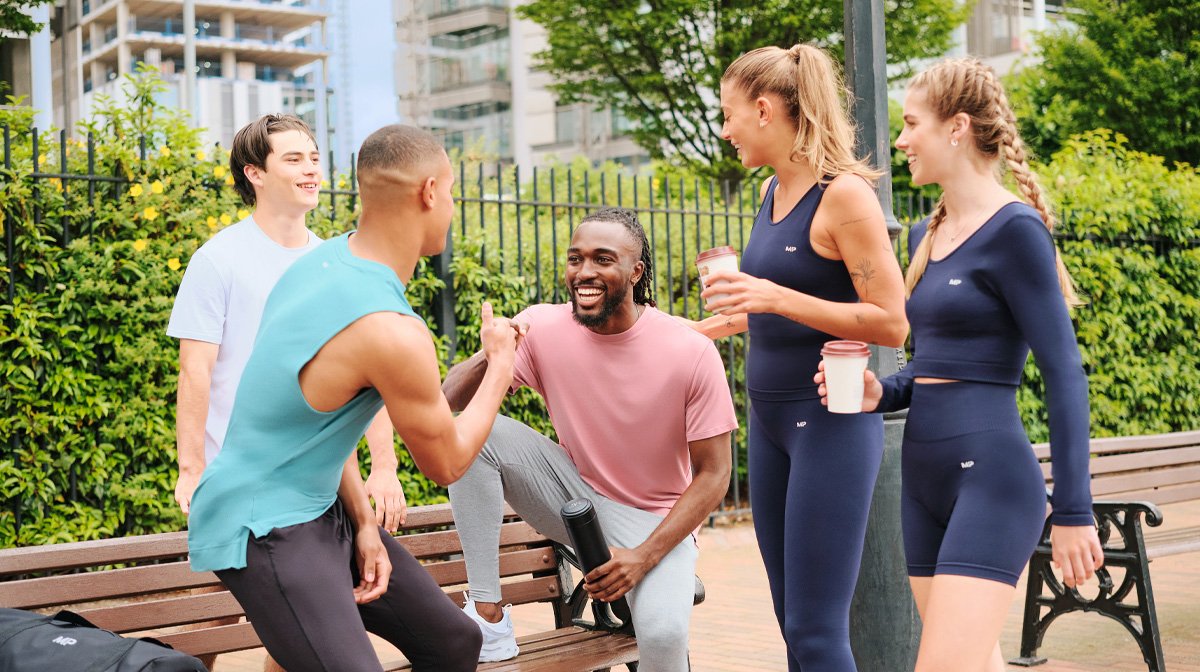
Exercises To Boost Your Energy
Tips & tricks to raise your energy levels in the gym.
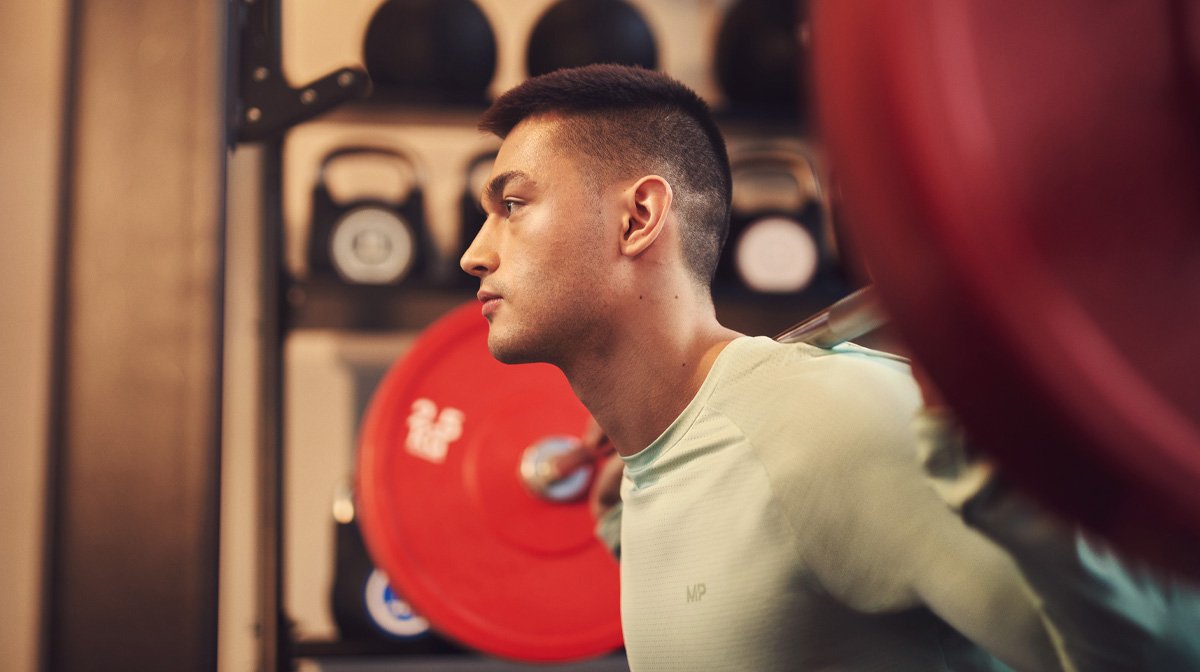
Why Is Strength Training Important?
Pick up the weights to improve your health & fitness.
Our articles should be used for informational and educational purposes only and are not intended to be taken as medical advice. If you're concerned, consult a health professional before taking dietary supplements or introducing any major changes to your diet.

Related Articles



